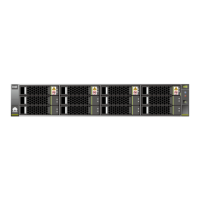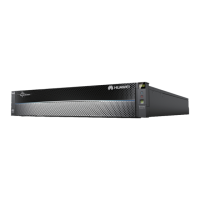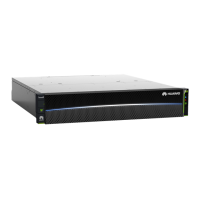Do you have a question about the Huawei OceanStor V3 Series and is the answer not in the manual?
Describes the background, definition, purposes, and benefits of the remote replication feature.
Details license requirements and compatible hardware/software for the remote replication feature.
Explains how remote replication replicates data, switches services, recovers data, and the role of consistency groups.
Outlines the compatibility considerations and restrictions for using the remote replication feature.
Discusses typical application scenarios for remote replication, including central backup, DR, and 3DC.
Describes the necessary network planning and replication links for remote replication configuration.
Details capacity planning and bandwidth planning considerations for remote replication.
Provides a step-by-step guide on configuring remote replication, including pair setup and data synchronization.
Covers essential preparations like license activation, device information, and host port selection.
Explains how to verify the validity and capacity of the remote replication license file.
Details how to configure routes for iSCSI networking across different network segments.
Describes establishing a logical connection between local and remote storage devices for data transfer.
Guides on creating synchronous and asynchronous remote replication pairs.
Explains how to create and manage consistency groups for data consistency across multiple LUNs.
Details steps to verify successful data replication, switchovers, and data recovery after configuration.
Provides a practical example of configuring remote replication for central backup and disaster recovery.
Enables viewing existing remote replication pair information for monitoring status.
Allows changing synchronization type, speed, and recovery policy of a remote replication pair.
Ensures data consistency by synchronizing a remote replication pair when data is inconsistent.
Stops data replication to save a point-in-time copy or expand network bandwidth.
Switches roles of primary and secondary resources in a replication pair, changing data direction.
Switches LUN owning controllers to ensure primary/secondary LUNs share the same controller.
Synchronizes data and status from a remote storage system to a local storage system.
Removes a remote replication pair, deleting its configuration and canceling replication.
Displays real-time performance indicators like bandwidth, sync duration, and time difference.
Enables viewing information about existing consistency groups and their replication pairs.
Allows modification of consistency group name, description, recovery policy, and rate.
Initiates simultaneous data synchronization for all replication pairs within a consistency group.
Splits all remote replication pairs in a consistency group simultaneously for full data copies.
Switches primary/secondary LUN roles within a consistency group for service continuity.
Protects secondary resources in consistency groups, making them read-only for security.
Disables protection for secondary resources, allowing secondary data to be written again.
Adds a remote replication pair to a consistency group, ensuring data consistency at the same point.
Removes a remote replication pair from a consistency group.
Deletes an unwanted consistency group and its associated configuration.
Enables viewing information about existing remote storage devices.
Allows changing authentication information and data compression policy for replicated devices.
Enables modification of bandwidth and bandwidth utilization for remote links.
Removes unwanted links between local and remote storage devices.
Removes unwanted remote storage devices from the system.
Compares synchronous and asynchronous remote replication based on implementation and application scenarios.
Explains how to access or use the secondary LUN, including snapshot mapping and switchovers.
Addresses issues with real-time updates for primary/secondary device names and sync progress.
Clarifies the relationships between replication tasks, clones, and consistency groups.
Explains bandwidth principles for optimal system performance in replication and LUN copy.
Provides precautions for creating remote links, including link type and version compatibility.
Details planning reserved space for asynchronous replication, focusing on COW functionality.
Explains how modifying consistency group properties affects its member pairs' working properties.
Discusses the requirement and recommendation for initial synchronization in remote replication tasks.
Clarifies if services need to be stopped on the primary system before initial synchronization.
Describes the impact of secondary storage system failure on the remote replication relationship.
Confirms if file and block remote replication utilize the same licensing.
Explains bandwidth differences in asynchronous replication and how to address them.
Provides troubleshooting steps for remote connection failures related to the TOE interface module.
Discusses synchronization interruption during synchronous replication due to long latency.
Explains reasons why a secondary LUN might not be displayed when creating a remote replication pair.
Introduces using external storage for initial synchronization to reduce time in large data scenarios.
Details creating a LUN copy on external storage for initial synchronization.
Explains creating LUN copies on production and DR centers for initial synchronization.
Guides on collecting troubleshooting information and making debugging preparations before contacting support.
Advises on using provided guide documents for daily maintenance and troubleshooting.
Details how to access Huawei's technical support through websites and regional offices.
Provides contact information for Huawei technical support and service.
Describes the background, definition, purposes, and benefits of the remote replication feature.
Details license requirements and compatible hardware/software for the remote replication feature.
Explains how remote replication replicates data, switches services, recovers data, and the role of consistency groups.
Outlines the compatibility considerations and restrictions for using the remote replication feature.
Discusses typical application scenarios for remote replication, including central backup, DR, and 3DC.
Describes the necessary network planning and replication links for remote replication configuration.
Details capacity planning and bandwidth planning considerations for remote replication.
Provides a step-by-step guide on configuring remote replication, including pair setup and data synchronization.
Covers essential preparations like license activation, device information, and host port selection.
Explains how to verify the validity and capacity of the remote replication license file.
Details how to configure routes for iSCSI networking across different network segments.
Describes establishing a logical connection between local and remote storage devices for data transfer.
Guides on creating synchronous and asynchronous remote replication pairs.
Explains how to create and manage consistency groups for data consistency across multiple LUNs.
Details steps to verify successful data replication, switchovers, and data recovery after configuration.
Provides a practical example of configuring remote replication for central backup and disaster recovery.
Enables viewing existing remote replication pair information for monitoring status.
Allows changing synchronization type, speed, and recovery policy of a remote replication pair.
Ensures data consistency by synchronizing a remote replication pair when data is inconsistent.
Stops data replication to save a point-in-time copy or expand network bandwidth.
Switches roles of primary and secondary resources in a replication pair, changing data direction.
Switches LUN owning controllers to ensure primary/secondary LUNs share the same controller.
Synchronizes data and status from a remote storage system to a local storage system.
Removes a remote replication pair, deleting its configuration and canceling replication.
Displays real-time performance indicators like bandwidth, sync duration, and time difference.
Enables viewing information about existing consistency groups and their replication pairs.
Allows modification of consistency group name, description, recovery policy, and rate.
Initiates simultaneous data synchronization for all replication pairs within a consistency group.
Splits all remote replication pairs in a consistency group simultaneously for full data copies.
Switches primary/secondary LUN roles within a consistency group for service continuity.
Protects secondary resources in consistency groups, making them read-only for security.
Disables protection for secondary resources, allowing secondary data to be written again.
Adds a remote replication pair to a consistency group, ensuring data consistency at the same point.
Removes a remote replication pair from a consistency group.
Deletes an unwanted consistency group and its associated configuration.
Enables viewing information about existing remote storage devices.
Allows changing authentication information and data compression policy for replicated devices.
Enables modification of bandwidth and bandwidth utilization for remote links.
Removes unwanted links between local and remote storage devices.
Removes unwanted remote storage devices from the system.
Compares synchronous and asynchronous remote replication based on implementation and application scenarios.
Explains how to access or use the secondary LUN, including snapshot mapping and switchovers.
Addresses issues with real-time updates for primary/secondary device names and sync progress.
Clarifies the relationships between replication tasks, clones, and consistency groups.
Explains bandwidth principles for optimal system performance in replication and LUN copy.
Provides precautions for creating remote links, including link type and version compatibility.
Details planning reserved space for asynchronous replication, focusing on COW functionality.
Explains how modifying consistency group properties affects its member pairs' working properties.
Discusses the requirement and recommendation for initial synchronization in remote replication tasks.
Clarifies if services need to be stopped on the primary system before initial synchronization.
Describes the impact of secondary storage system failure on the remote replication relationship.
Confirms if file and block remote replication utilize the same licensing.
Explains bandwidth differences in asynchronous replication and how to address them.
Provides troubleshooting steps for remote connection failures related to the TOE interface module.
Discusses synchronization interruption during synchronous replication due to long latency.
Explains reasons why a secondary LUN might not be displayed when creating a remote replication pair.
Introduces using external storage for initial synchronization to reduce time in large data scenarios.
Details creating a LUN copy on external storage for initial synchronization.
Explains creating LUN copies on production and DR centers for initial synchronization.
Guides on collecting troubleshooting information and making debugging preparations before contacting support.
Advises on using provided guide documents for daily maintenance and troubleshooting.
Details how to access Huawei's technical support through websites and regional offices.
Provides contact information for Huawei technical support and service.
| Supported Protocols | FC, iSCSI, NFS, CIFS |
|---|---|
| RAID Support | RAID 0, 1, 3, 5, 6, 10, 50 |
| Controller | Redundant, active-active controllers |
| Cache | Up to several GB per controller |
| Snapshot | Supported |
| Replication | Supported |
| Form Factor | Rack-mountable |
| Controllers | Dual controllers |
| Host Interface | 8Gbps/16Gbps FC, 1Gbps/10Gbps iSCSI |
| Drive Types Supported | SSD, SAS, NL-SAS |
| Operating System | Huawei OceanStor OS |
| Data Protection | RAID, Snapshot, Replication |
| Data Services | Thin Provisioning |
| Management | Web-based GUI, CLI, SNMP |
| Scalability | Scalable capacity and performance |
| High Availability | Redundant hardware, hot-swappable components, automatic failover |
| Power Supply | Redundant power supplies |











